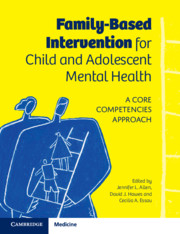Book contents
- Family-Based Intervention for Child and Adolescent Mental Health
- Family-Based Intervention for Child and Adolescent Mental Health
- Copyright page
- Contents
- Contributors
- Preface
- Part I Theoretical Perspectives on Family-Based Intervention
- Part II Core Clinical Competencies
- Part III Family Intervention for Specific Child and Adolescent Mental Health Problems
- Chapter 8 A Family-Based Approach to the Treatment of Youth Depression
- Chapter 9 A Family-Based CBT Approach to the Treatment of Anxiety Disorders in Children and Adolescents
- Chapter 10 Case Complexity and Resistance to Change in the Treatment of Child Conduct Problems
- Chapter 11 Enhancing Engagement and Motivation with Adolescents with ADHD and Their Parents
- Chapter 12 Functional Family Therapy for Antisocial Behaviour in Adolescents
- Chapter 13 Autism Spectrum Disorders in Young Children
- Chapter 14 Family-Based Treatment for Eating Disorders
- Chapter 15 Sleep Problems
- Part IV Family Intervention for Children at Risk Due to Family Dysfunction or Past Adversity
- Part V New Developments in Family-Based Intervention
- Index
- References
Chapter 8 - A Family-Based Approach to the Treatment of Youth Depression
from Part III - Family Intervention for Specific Child and Adolescent Mental Health Problems
Published online by Cambridge University Press: 18 February 2021
- Family-Based Intervention for Child and Adolescent Mental Health
- Family-Based Intervention for Child and Adolescent Mental Health
- Copyright page
- Contents
- Contributors
- Preface
- Part I Theoretical Perspectives on Family-Based Intervention
- Part II Core Clinical Competencies
- Part III Family Intervention for Specific Child and Adolescent Mental Health Problems
- Chapter 8 A Family-Based Approach to the Treatment of Youth Depression
- Chapter 9 A Family-Based CBT Approach to the Treatment of Anxiety Disorders in Children and Adolescents
- Chapter 10 Case Complexity and Resistance to Change in the Treatment of Child Conduct Problems
- Chapter 11 Enhancing Engagement and Motivation with Adolescents with ADHD and Their Parents
- Chapter 12 Functional Family Therapy for Antisocial Behaviour in Adolescents
- Chapter 13 Autism Spectrum Disorders in Young Children
- Chapter 14 Family-Based Treatment for Eating Disorders
- Chapter 15 Sleep Problems
- Part IV Family Intervention for Children at Risk Due to Family Dysfunction or Past Adversity
- Part V New Developments in Family-Based Intervention
- Index
- References
Summary
Treatment of depression during childhood and early adolescence frequently involves numerous challenges, including co-morbidity, stress and mental health problems within the family. Given the embeddedness of youth within family structures during this developmental period, a family-based model may be particularly advantageous. Family-focused treatment for childhood depression (FFT-CD) is a developmentally-informed intervention that specifically targets family interactions to build strengths and resiliency within the family system to better manage and combat depression. By incorporating an interpersonal model, family members are assisted in identifying both ‘upward’ (helpful and positive) and ‘downward’ (unhelpful and negative) interactional spirals. This model provides a powerful and positive rationale for family inclusion in treatment and specifies the goals of the intervention. In further family sessions, psycho-education, communication enhancement, behavioral activation and problem-solving skills development are then used to build on existing strengths and disrupt negative transactions. In this chapter we describe the conceptual roots and intervention strategies of FFT-CD, illustrate its implementation using case descriptions and discuss core clinician competencies and approaches to common challenges in its implementation (e.g., co-morbidity, sibling inclusion, family stress). FFT-CD provides a flexible and efficacious intervention for depressive symptoms and disorders during a crucial period of development.
Keywords
- Type
- Chapter
- Information
- Family-Based Intervention for Child and Adolescent Mental HealthA Core Competencies Approach, pp. 87 - 99Publisher: Cambridge University PressPrint publication year: 2021



